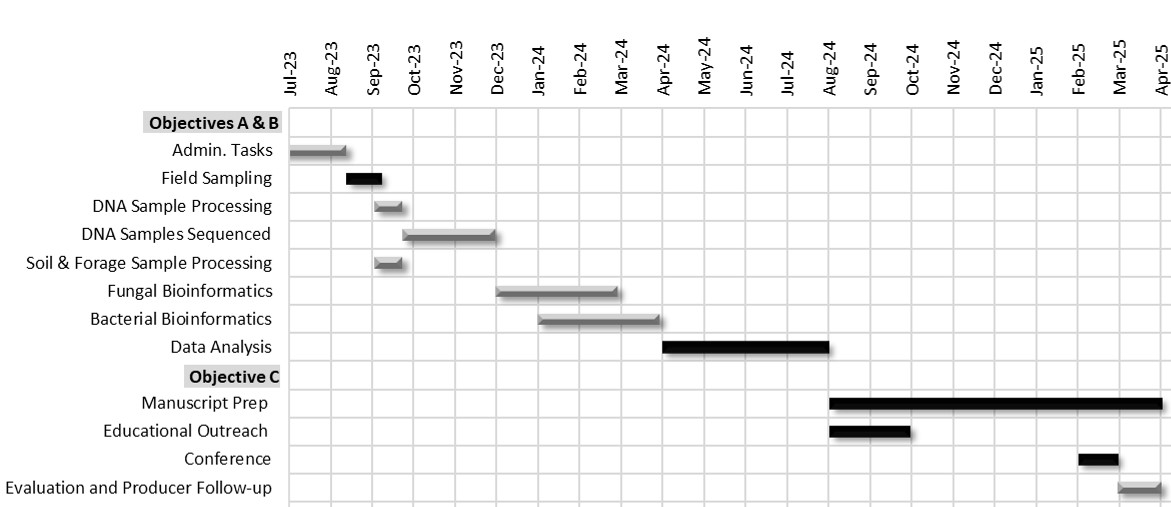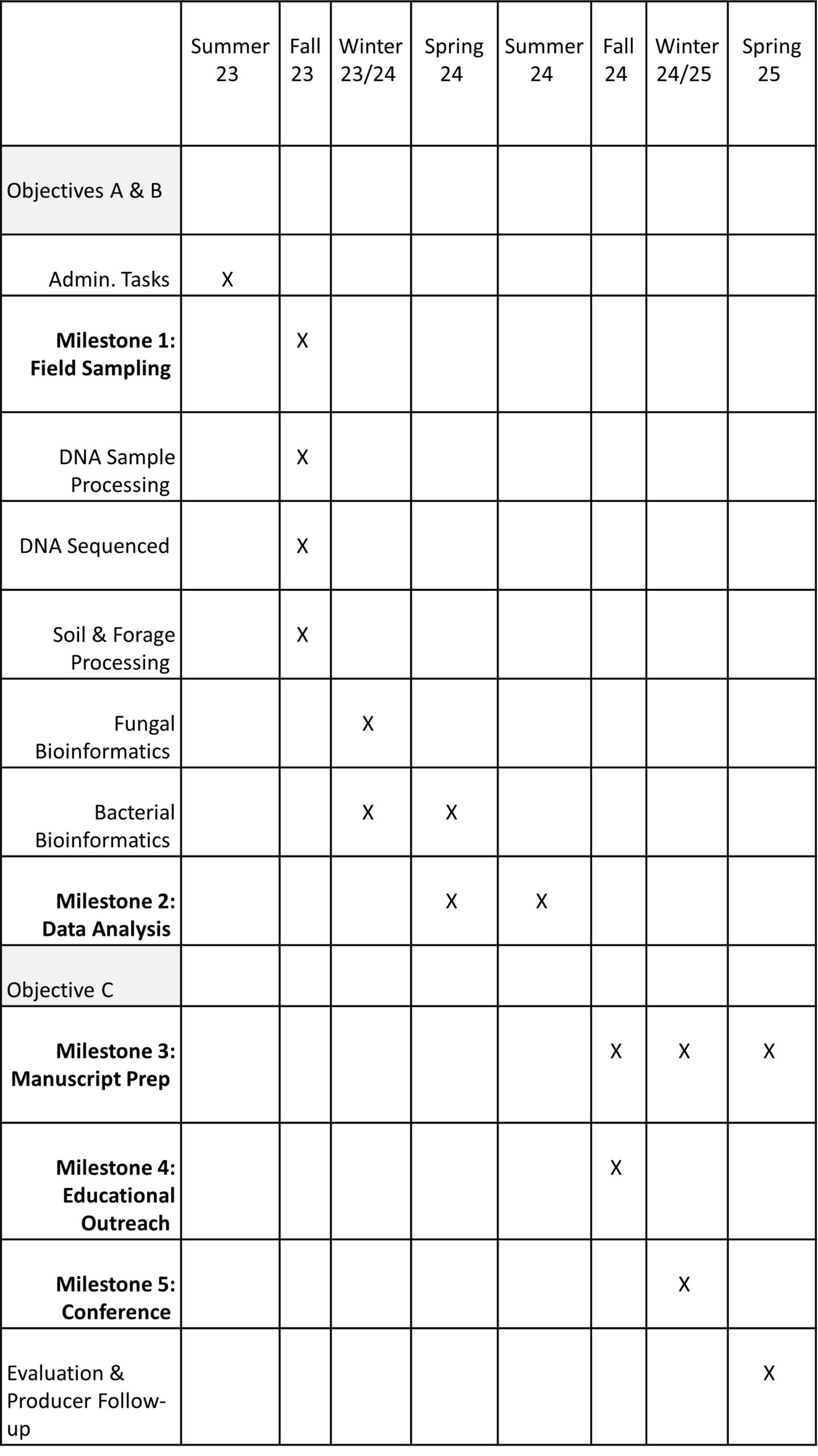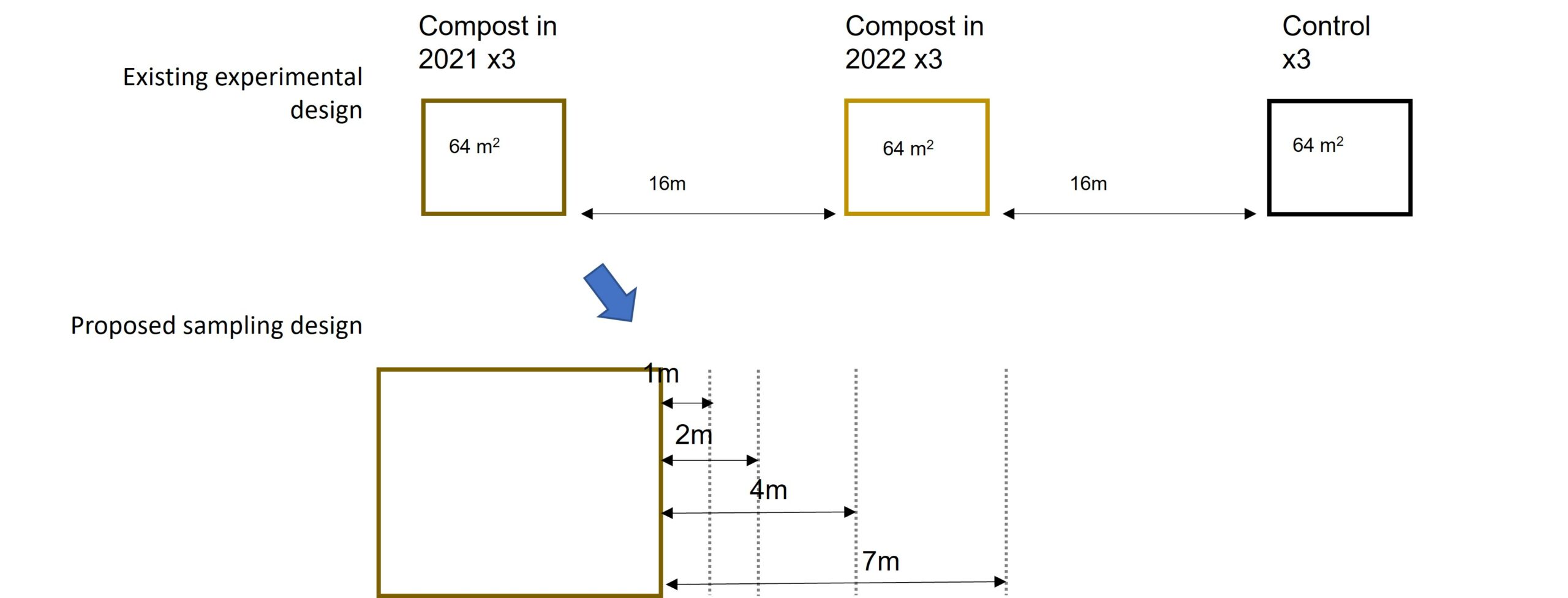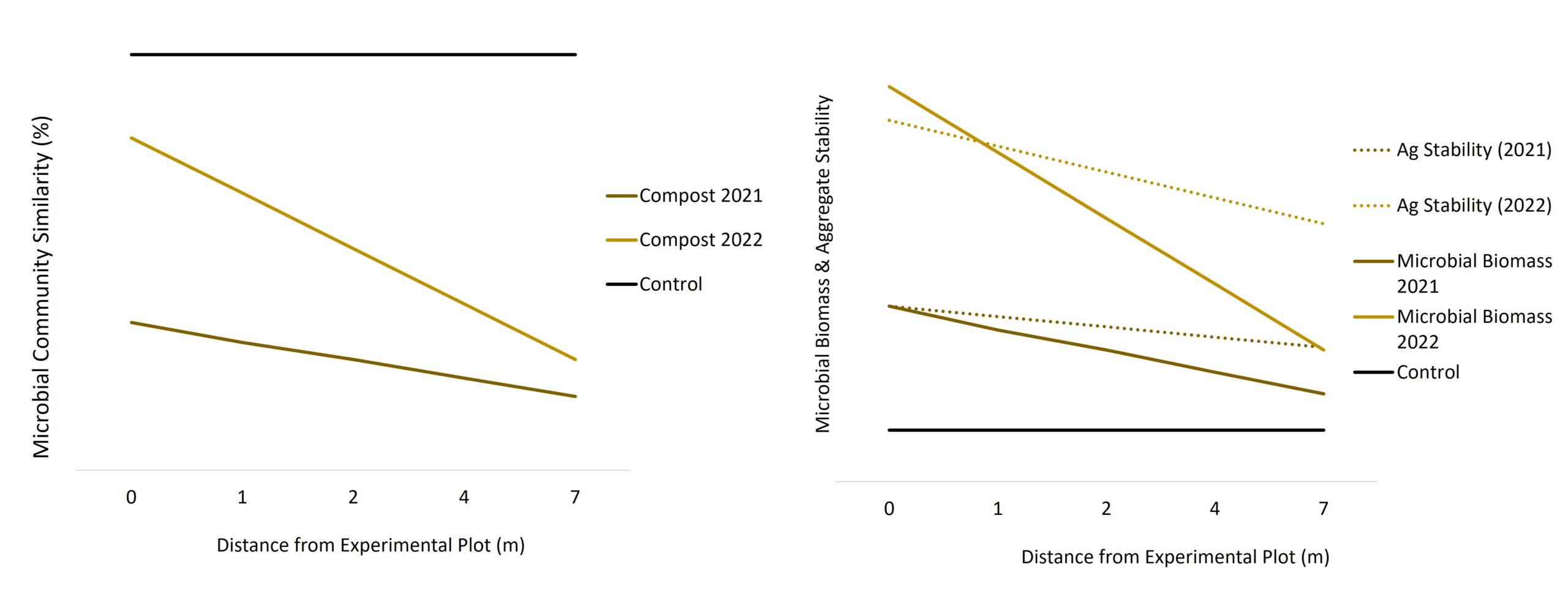Progress report for OW23-379
Project Information
Western rangeland producers are faced with threats to their livelihoods as overgrazing has led to degraded soils and climate change-induced precipitation variability has made forage quantity difficult to predict. Sustainable management strategies are being promoted to ensure food system resilience and a healthy environment. Compost amendment is key to these strategies because of its ability to increase soil stability, water holding capacity, carbon and forage biomass. Because beneficial effects are observed even with small amounts of compost, microbial additions are likely pivotal to benefits because the novel community can potentially change the composition, function and plant/microbe relationships in native soil communities. These changes may extend beyond the compost application site but dispersal success and functional impacts of microbes have yet to be evaluated. This knowledge gap hinders producers’ ability to make informed decisions about optimal use of compost amendments.
This study leverages existing field trials combined with DNA sequencing and established soil/forage assessment methods to identify successfully dispersing taxa, their functional traits and correlated effects on forage biomass and soil structure outside of the application site over time. Outcomes will inform producers about best application practices, possibly reducing the amount of compost needed and labor required to meet management goals. Results will be disseminated via field days, a webinar, a conference presentation and a paper. Data will be shared with RAMPS (Restoration Assessment and Monitoring Program for the Southwest) and RestoreNet, assisting land management agencies and producers in developing techniques for improving farming practices.
Research Objectives
- Determine how far bacterial and fungal components of compost-inoculated plots disperse to adjacent soils and how much bacterial and fungal biomass changes in adjacent soils. Investigate the traits of microbial taxa that preferentially disperse and their potential functional contributions to adjacent soils.
- Determine how transferred microbial communities affect plant biomass and soil structure.
Education Objectives
- Based on the results of objectives A+B, provide technical support through education for interested producers. Engage the general public by sharing results in a fun and engaging manner at educational events.
Ranchers manage waste products such as manure and thinned woody biomass and composting and amending soils can make productive use of this waste, mitigating detrimental environmental impacts that result from current disposal methods, thus improving the health and safety of the community. The benefits of compost addition to soil and plant health in rangeland systems have been well documented (1–6); however, research on the role of compost-associated microbes is in its infancy and there have been no studies investigating how far the microbial community and their effects on the environment will disperse. Investigation of the dispersal of compost microbes will address SARE’s goals of improving farmer and rancher quality of life and good stewardship of land by providing evidence on how far the beneficial effect of compost extends beyond the initial application area while still improving soil structure and plant health, potentially resulting in cost savings. Studies indicate that microbial diversity can promote plant community diversity, with microbes functioning in mutualistic or commensal relationships or as pathogens (7–9). Taxonomic classification of the community will identify known pathogens or beneficial microbes that will help determine potential impacts on forage species diversity. To assess the environmental implications of microbial dispersal, we will focus on soil structure and forage biomass, assessing the ability of microbes to combat soil degradation and increase forage yield.
Research will be conducted at three sites in New Mexico across different elevations, soils, and climate (Table 1) to assess impacts across a broad set of southwestern rangeland conditions. Our proposed research leverages existing experimental sites that were inoculated with ¼” of compost in 2021 and 2022 allowing for study of microbial dispersal and function at agriculturally relevant time scales.
Table 1. Abiotic and vegetation characteristics of the three ranches in New Mexico to be used to study microbial dispersal.
| Location | Temperature: mean low, mean high °C | Mean annual precipitation (mm) | Elevation (m) | Dominant vegetation | Land use |
| Rio Arriba County | -3.3, 15.9 | 425 | 2295 | Blue grama grassland with pinyon juniper or ponderosa forest | Cattle grazing |
| Sandoval County | 5, 21.1 | 308 | 1600 | Galleta/sand dropseed grassland | Cattle grazing |
| Socorro County | 5.8, 23.3 | 278 | 1455 | Black grama with creosote shrubs | Big game grazing |
See figures 3 and 4.
The project would start July 1st, 2023, with administrative duties such as ordering supplies occurring immediately. Corresponding with the first major milestone, field sampling and sample processing by the Agricultural Technical Advisor and student would be done at the end of August/early September. Illumina sequencing of the microbial community, quantification via qPCR and bioinformatic analysis will be a time intensive component and will be completed by the end of March 2024.
The second major milestone, data analysis, is the responsibility of the Agricultural Technical Advisor and includes processing data from soil and forage measurements, DNA sequencing and quantification and assignment of taxon functional traits. Analysis of soil, forage and sequencing data is scheduled to occur from April 2024 through May 2024, with functional trait assignment occurring secondarily, June and July 2024, due to its reliance on analysis of DNA sequencing.
Addressing objective C2 of the Education Plan, major milestones in year 2 include production of a manuscript which will be co-written by the PI and Agricultural Technical Advisor as soon as data analysis is complete and will then be submitted to a peer-reviewed journal in March 2025. Raw data and results will also be provided to RAMPS and RestoreNet in March 2025. Concurrently, the Agricultural Technical Advisor will present data at local field days in August and September of 2024 and at the Society of Range Management Conference in February 2025.
The time commitment from the PI and Agricultural Technical Advisor may vary from month-to-month but will balance to 4% and 25% of their salaries, respectively, that have been requested. The remaining portion of their salaries are supported by dual appointment with Quivira Coalition and the existing AFRI grant, respectively.


Cooperators
- - Technical Advisor
- - Producer
- - Producer
- - Producer
Research
The proposed study has two primary research objectives, A) determine how far compost derived microbial communities disperse beyond the primary application site, B) investigate whether this dispersal is beneficial to plant biomass and soil health.
Plot Design: At three ranches with differing environmental conditions (Table 1), experimental plots were inoculated at ¼” depth with manure compost on sites with <5% slope in summer 2021 and 2022 and are 64 m2, with 16 m between plots. Plots were randomly assigned to compost (n = 3 for 2021, n = 3 for 2022) or control plots (n = 3). Existing data for these sites includes initial microbial composition of soils and compost, plant biomass and soil properties and sampling from 2022. As part of the existing Agriculture and Food Research Initiative grant 2021-67019-34249, we will measure the microbial community and plant/soil characteristics inside the plots in August-September 2023.
Proposed Sampling Design: The space between plots will be used to sample multiple distances from existing plots in 2023. New 8 m long transects will be established parallel to the edge of the plot at distances of 1, 2, 4 and 7 m away from the plot (Figure 1). Transects will be placed on the most level side of the plots to minimize effects of water runoff spreading compost.
Objective A1) Determine how far and how rapidly fungal and bacterial components of compost will disperse away from compost application sites.
We will use Illumina sequencing to identify individual genera, and species (when possible), along a distance gradient. Sterilized soil cores will be used to collect 8 soil samples to a depth of 10 cm along each transect. Cores will be homogenized, and 25 mg will be used for DNA extraction via a standard soil extraction kit, following manufacturer protocols. Extractions will be sent for whole fungal and bacterial community sequencing of the ITS2 and 16S regions, respectively, at the University of Arizona Genetics Core. Microbial community composition and relative abundances of these organisms at each sampling point will be analyzed via USEARCH and Qiime2 (Quantitative Insights into Microbial Ecology, version 2), software packages that will assign microbial identity and the frequency of occurrence of each organism will be completed in March 2024. We will assess differences in relative microbial community by distance using a PERMANOVA (Permutational Multivariate Analysis of Variance) using a Bray Curtis similarity matrix and be completed in May 2024.
Objective A2) Determine if microbial biomass will increase along a distance gradient adjacent to compost application sites.
Using samples and microbial community data collected from A1, qPCR (quantitative polymerase chain reaction), a method to quantify DNA, will be used to determine absolute abundances of bacteria and fungi at each distance. Statistical analysis will be the same those used in Objective A1 and be completed concurrently.
Objective A3) Determine if specific microbial taxa differentially disperse outside the compost application site and their potential specialized functions such as N2 fixation.
Using samples and microbial community data collected from Objective A1, microbial function will be identified using publicly available databases such as FUNGuild (Fungi Functional Guild) and literature available via GenBank. Statistical analyses will be the same as those used in A1. Assessment of functional implications are part of data analysis but will occur in June and July 2024 after results are obtained from A1.
We hypothesize that compost associated microbial community similarity will be negatively correlated with distance from the application site (Figure 2a) based on the distance-decay theory (16), of which dispersal is a determining factor (17). Transects nearest the application site will require fewer dispersal pressures than those farther away, and experience not only wind and animal transport but also water-based transport through soil pores. If wind and animal transport occur gradually, differences between distances in plots with compost addition in 2021 will be weak and relatively stronger for the plots where compost was added in 2022. However, if the tenet “everything is everywhere and the environment selects” holds true microbial community structure will not vary strongly by distance between years (Figure 2a).
We hypothesize that fungi with active or ejection-based dispersal mechanisms will be the dominant fungal components at the farthest distances as they will benefit from this additional method of transport. The most successful bacterial dispersers will be within the Actinomycetes phylum because they are able to produce their own mycelial network (18) and are successful components of the microbial community in environments subject to high temperature or water stress (19). Overall bacterial biomass will be positively correlated with Basidiomycetes as these fungi can form hyphal “highways” (20,21) which assist with bacterial transport.
Objective B) Determine if the benefits of compost on soil properties and plant biomass will be present adjacent to the compost application site and if this correlates with microbial community shifts.
Six soil samples will be collected per transect/plot and aggregate stability will be assessed using Herrick et al.’s method (22).
Infiltration rate will be determined by using the NRCS (Natural Resources Conservation Service) Infiltration Protocol. As water infiltration is unlikely to change at the scale between transects, measurements will be taken inside the plot and at 7 m.
Aboveground biomass will be determined using Nutnet protocols (23) using clip strips at each transect providing 5 sampling points per transect. Plant material will be clipped to the top of the root crown, 1 cm above the ground. Biomass will be transported to the lab, sorted to remove oxidized standing biomass, dried and weighed.
Soil properties and plant biomass results will be compared to microbial biomass and community composition to correlate potential relationships (Figure 2b).
We hypothesize that water infiltration, aggregate stability and aboveground biomass will be highest inside the plot and decrease in a similar fashion to that of microbial biomass (Figure 2b). Microbial biomass will likely decrease over time and with increasing distances from the application site. In conjunction with these decreases aggregate stability and water infiltration will decrease; however, drops will be less dramatic than those of biomass. Because aggregate stability and water infiltration increases are potentially due to microbial extrusion of exopolysaccharides, which function as binding agents and have high water holding capacity (24), stabilization and water holding services remain after microbes have died, extending their beneficial services temporally. Forage biomass changes are expected to be associated with specific microbial taxa and their corresponding functional role, pathogenesis for example causing a reduction in biomass.
Implications for researchers: Correlating the results of ecological responses to specific taxonomic groups may provide novel, testable hypotheses for which taxa drive function in drylands.


Objective A1) Determine how far and how rapidly fungal and bacterial components of compost will disperse away from compost application sites. Objective A2) Determine if microbial biomass will increase along a distance gradient adjacent to compost application sites. Objective A3) Determine if specific microbial taxa differentially disperse outside the compost application site and their potential specialized functions such as N2 fixation.
We are still analyzing these results and will present during the next time period.
Objective B) Determine if the benefits of compost on soil properties and plant biomass will be present adjacent to the compost application site and if this correlates with microbial community shifts. WSARE 240328 Figures
There were no differences in infiltration time by compost/year treatment at any site (all main effects and interactions P > 0.05; Table 1, Figure 1). There were therefor also no differences in infiltration time with distance from treatment or by treatment type at any site (all main effects and interactions P > 0.05; Table 2; Fig. 3). We did have the power with this design to detect differences because we found significant differences in infiltration rate by site (P < 0.001; Table 1; Table 2).
Although there were some differences in aggregate stability measured by the slake test by compost treatment/Year treatment at the TUR site (Table 1; Fig. 2), there were no differences by distance from the compost treatment (Table 2; Fig. 4). We did have the power to detect differences because we found significant differences in by site x treatment/year (P < 0.10; Table 1; Table 2).
Table 1. Analysis of variance results for infiltration rate and aggregate stability by compost/year treatment combination (Five levels: control, and manure-based vs. food-based compost added in 2021 or 2022).
|
|
|
Infiltration time |
|
Aggregate stability |
|
|
|
Df |
F |
P |
F |
P |
|
Compost/Year treatment |
4 |
0.82 |
0.515 |
2.47 |
0.053 |
|
Site |
2 |
11.08 |
<0.001 |
4.44 |
0.015 |
|
Compost/Year x Site |
8 |
0.64 |
0.742 |
1.99 |
0.058 |
|
Adj. R2 |
|
0.16 |
|
0.19 |
|
Table 2. Analysis of variance results for infiltration rate and aggregate stability by distance (inside = 0m up to 7m) from amendment plot by compost/year treatment combination (Five levels: control, and manure-based vs. food-based compost added in 2021 or 2022).
|
|
|
Infiltration time |
|
Aggregate stability |
|
|
|
df |
F |
P |
F |
P |
|
Distance |
1 |
0.36 |
0.551 |
0.01 |
0.921 |
|
Compost/Year treatment |
4 |
0.67 |
0.616 |
5.23 |
0.001 |
|
Site |
2 |
29.40 |
<0.001 |
6.83 |
0.001 |
|
Distance x Compost/Year |
4 |
0.55 |
0.700 |
0.25 |
0.911 |
|
Distance x Site |
2 |
1.69 |
0.190 |
1.39 |
0.252 |
|
Compost/Year x Site |
8 |
0.523 |
0.836 |
2.40 |
0.017 |
|
Distance x Compost/Year x Site |
8 |
0.517 |
0.841 |
1.62 |
0.121 |
|
Adj. R2 |
|
0.26 |
|
0.16 |
|
Research Outcomes
Methods recommendation:
We determined in the field that none of our methods for vegetation monitoring were suitable for accurately capturing changes in vegetation with distance from the plot. Because the vegetation was so patchy at each site naturally, we realized that whether we attempted transects or to use random clip plots to equal the area clipped inside the plots, we were unlikely to be able to detect differences over the spatial scale.
Education and Outreach
Participation Summary:
Objective C1) Outreach with producers.
We will participate in two local outreach events, a field day hosted by the Armendaris
ranch and the Santa Ana Pueblo’s Health and Environment Fair in fall 2024 where study results and general information about compost will be presented. Content will be directed at a range of audience members, from producers currently using compost to the general public. Fact sheets with the study results will be created and used to engage producers in a general discussion about their views on compost use and more specifically about how the research might impact their ranches. These will also be distributed through our partner organization Quivira Coalition. A poster on the general benefits of compost in agriculture will be used at Santa Ana Pueblo’s Health and Environment Fair to engage producers not currently familiar with compost, in order to increase the awareness of its benefits and discuss barriers to its use. Samples of compost, a demonstration of its water holding capacity and of a composting setup that attendees can make at home will be provided for the general audience. To ensure outreach includes the Esquibel ranch, its network and those unable to attend field or fair days, we will host a webinar fall 2024. The webinar will include background on what compost is and its benefits in rangelands, as well as key takeaways from the study such as microbial dispersal abilities and correlations with soil and forage health. Study results will be streamlined to present engaging and actionable data. Collaborating producers will provide input on the impact of compost, implementation strategies and barriers to its use.
Technical support based on the project results can also be communicated individually by consultations with the Agricultural Technical Advisor.
The Santa Ana Pueblo is a collaborator on this project and is considered a Traditionally Underserved Producer community. The health and environment fair will specifically target this community, providing information to both the producers and the general Tribal community in a fun and informative manner.
Objective C2) Outreach with scientific and management community.
We will give an oral or poster presentation at the Society of Range Management Conference in February 2025 to communicate results to a regional audience.
We will also publish results in a peer-reviewed academic journal to disseminate results to an international audience. A manuscript will be submitted in March 2025. DNA sequencing data will also be submitted to GenBank, the standard microbial sequencing database.
We will provide study results and raw data to RAMPS (Restoration Assessment and Monitoring Program for the Southwest) and RestoreNet, assisting land management agencies and producers in developing techniques for improving farming practices. Data will be provided in March 2025.
Objective C1. Outreach with producers.
Dr. Sticker tabled with an interactive exhibit on soil and compost microbes. Santa Ana Pueblo Environmental Fair. Aug. 2023. Santa Ana Pueblo, NM.
We attended the Quivira Coalition 2023 Fall Red Canyon Reserve Gathering (October 2023) to discuss how soil health principles and circular economy concepts relate to using organic amendments in rangeland management. We then toured the Armendaris Ranch experimental site and demonstrated monitoring techniques.
We were unable to complete a field day at Esquibel Ranch in summer 2023; instead we were invited to contribute an article for the Resilience magazine that used Esquibel as the main focus. That magazine is distributed to >3000 people.
Stricker, E. Bethany Rakes, J, O’Connell, M. 2023. “Souls of the Soil: Microbes and Managers Helping to Restore Degraded Rangelands.” Resilience Magazine, Quivira Coalition. https://quiviracoalition.org/resilience-44/
We also partnered with Quivira Coalition for Stricker to provide a plenary talk at their annual conference: Stricker E. “‘It depends’ and other aspects of microbial ecology in agriculture.” REGENERATE conference. Nov. 2023. Santa Fe, NM.
Objective C2) Outreach with scientific and management community.
Keynote address: Society for Ecological Restoration Southwest. “Organic amendments on dry rangelands: can principles of circular economy and soil health principles meet the needs of land stewards?” Nov. 2023.
We have submitted an abstract for the Ecological Society for America Annual conference in August 2024 and will submit an abstract for the Biennial Conference of Science & Management on the Colorado Plateau & Southwest Region.
Education and Outreach Outcomes
The most common question/feedback that our team receives is how much compost amendments cost; producers seem to have low interest in the ecological results without the context of the costs which was outside of the current scope of project. However, as we finalize our publication and outreach materials in the coming year, we will be sure to compile and include those costs, even though they are likely higher to conduct research-scale interventions than they would be if a producer were using these techniques at scale.
Frequently, people express interest in making compost on their operations as a result of our discussions of the role of compost in the diversion of waste and climate change, even before we discuss the role that it can play in dryland soil health.